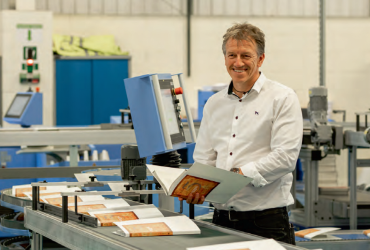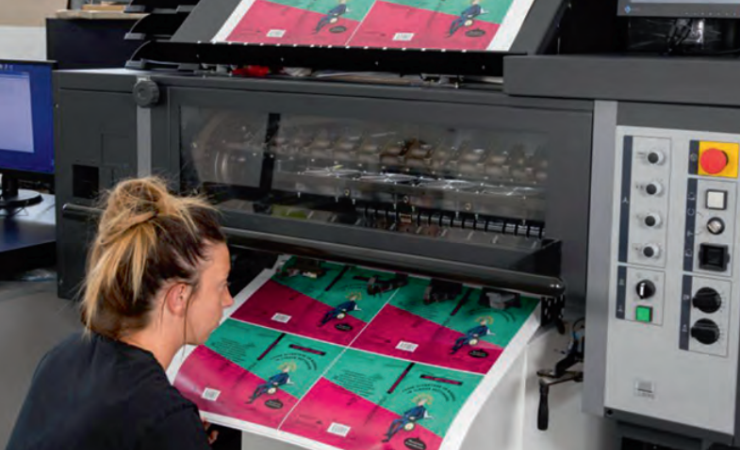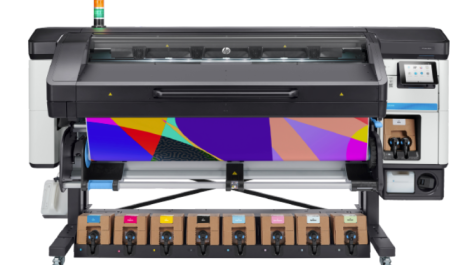Books are the original ‘killer app’ for print and in some ways, not much has changed in the centuries since Gutenberg.
They still have pages printed on paper and have covers that have to be bound in some way. They’ve survived bannings, burnings, and more recently, the rise of e-readers and even the Covid pandemic, which actually gave some categories a boost. What has changed of course, is how they’re printed and bound. The ‘print lots and hope to sell them all’ model is very much on the way out, with print-on-demand now being the norm for many publishers, reducing waste and inventory-related costs, and meaning that – provided the artwork is available in a suitable form – nothing need be ‘out of print’ any more.
Printing books is no longer the preserve of large printers either. Anyone with a digital press and some binding kit can get in on the game, and despite the presence of behemoths like Clays and CPI, who churn out millions of copies, there is still room in market for smaller players. That’s certainly the view of Dave Button of Essex-based 4edge, a specialist book printer that was set up in 2003 to tackle publishers’ backlists.
His plan from the outset was to focus solely on digital printing of books, and it worked: ‘We were very lucky, the market came to us,’ he recalls. His clients are mostly small-to-medium publishers, which the company has grown alongside. The work is wide ranging, including instruction manuals, journals, paperback, brochures and casebound books.
‘If it’s pages in a book, we do it,’ he says. On the press side, 4edge started with a Heidelberg Digimaster and a pre-Kodak Nexpress to serve this market. and have subsequently followed developments in toner print, both colour and mono. The company moved premises in 2017 with the plan to add an inkjet press, but so far hasn’t found the right one. ‘I’m quite fussy in terms of production, such as getting the grain direction of the paper right. The big players don’t do this,’ he adds. ‘We ensure it’s done the best as it can be, as it’s part of the publisher’s brand. We ensure the end result couldn’t be better in short-run.’
By short run he generally means under 2000 copies, and typically around 300, but 4edge has produced ‘book of one’ projects and still does occasionally. A key piece of equipment at the Essex site today is a Müller Martini InfiniTrim three-knife trimmer bought in 2018, which revitalised the business, according to Mr Button. Printing is nowadays done on a Canon ImagePress C8000 and a Konica Minolta C14000 for colour work and three Océ (as was) Titan presses. Unusually, 4edge operates a reel-to-sheet paper handling model in which the paper is cut before printing to feed to the cut-sheet presses, using kit from Tecnau and its predecessors. Mr Button says that as well as a saving on price for buying in reels, the system eliminates problems like double-feeding and can give an improved yield through careful cutting to size.
For certain formats, such as A4 books, the cross-grain issue that would arise from working from rolls means that cut-sheet is better and paper is bought that way for such products. Jobs are received by FTP or email. There’s no web portal, and Mr Button is unapologetic about that: ‘People use us because they want to, and we employ skilled people,’ he argues. Once jobs are received, they are processed through Canon’s Prisma software and job metadata is added to the PDFs, detailing attributes such as the extent, size and material requirements for each. The Canon software is also able to drive the Konica Minolta press. For jobs that don’t need to go through the InfiniTrim, there’s a Polar guillotine with a barcode reader to recall settings. Binding is handled by a Horizon BQ500 added in 2021, and a Müller Vareo digital perfect binder.
‘The only manual process is putting the book blocks into the binder,’ Mr Button says. Imposition is done via the metadata attached to the PDF at the outset. The company is in the process of building an extension to house the yet-to-be decided inkjet press; planning permission was granted in early 2020, but the pandemic caused a delay. It’s now scheduled to be finished later. in 2022, with the intention of having selected the press by the end of the year.
Scaling up an altogether bigger operation is TJ Books, a 53 year-old business that has been located in Padstow, Cornwall for nearly all of that time. It’s run by Andy Watts and financial director Andy Adams, who acquired it at the start of 2018, prior to which both had been in the book industry. Mr Watts had known the business previously and, wanting to ‘do something different’ and seeing ‘a gap for a more creative approach’ made a successful offer to the then owners. The years 2018 and 2019 went well. Mr Watts says that in 2018 he and Mr Adams ‘learned the business’ and in 2019 they drew up their strategy, with the plan for its implementation to happen in 2020. The arrival of Covid-19 saw 50% of sales lost overnight and the loss of a stock replenishment contract. The firm survived 2020 and saw recovery begin in 2021 and is now aiming to be back at pre-Covid levels by the end of 2023. Despite all this Mr Watts says, ‘we carried on, didn’t go off course’ and in 2020 and 2021 the company made significant investments totalling some £1.7 million in digital presses, MIS and infrastructure, also moving equipment around within the factory to improve physical workflow.
The goal was to achieve an automated production line, from paper reel to printed and bound softcover book or book block for case binding. This involved two parallel production lines based around existing Canon ColorStream web inkjets, bracketed by Hunkeler Book Line equipment for unwinding, and inline cutting, folding and binding. Two Müller Vareo perfect binders are used, together with an InfiniTrim for completed soft cover books or bound blocks for subsequent case binding. The Canon presses, which are between six and four years old, are about to be replaced with two ColorStream 8000 models, the first due to arrive in August and the second in October 2022. According to Mr Watts, these will bring greater flexibility in the company’s capacity, transferring more litho work to inkjet.
‘The market is going that way, with shorter runs and turnaround times,’ he notes. The shorter runs range from one copy up to about 1500, but the deciding factors include both run length and pagination. ‘We can back-fill the litho presses, there’s plenty of life left in them, but work that requires more setups will go inkjet,’ he explains. The Canon inkjets are complemented by Ricoh Pro C72000 and Pro C9200 cut-sheet toner machines, with long sheet capability for book jackets. There is also a Canon iX series cut-sheet inkjet, added in early 2021, to support a move into colour book production. This prints onto offset stocks, and filled a gap in the offering. These presses are supported by a Duplo DuSense digital UV coater, which has ‘been great, seen a lot of use and is perfect for short run’. The MIS part of the investment is the EFI Pace system, which went live in April 2021, replacing an older Imprint system. ‘It was a bit like going from litho to digital,’ says Mr Watts, ‘EFI gave us all the modules and visibility we needed, it’s future-proof.’ Workflow decisions on litho or digital print are still made by humans, but the system is fed with production information for scheduling, which includes live job feeds from TJ’s publisher clients. Turnaround is from 24 hours, depending on the service level agreement with each client.

A significant investment in presses, MIS and infrastructure has left Andy Watts of TJ Books feeling positive
The work for inkjet output is batched by the EFI MIS, which also carries out estimating and shopfloor data collection. Mr Watts is confident about the future. ‘We’re now back to pre-Covid levels with 146 staff and very positive about the business going forward. We’ve rebalanced financially and are adamant about sticking to our strategy – if you keep getting knocked off-course you’ll never get where you’re going. Bumps and hurdles are expected.’ Bella Italia Another large book printer is Grafica Veneta, located in the Padova area of northern Italy. Producing some 150 million books a year and with a turnover of €100 million, it operates from a 100,000sqm carbon-neutral facility driven by solar power and employing 750 people.
Since 2021 it has also owned Lake Book Manufacturing of the US, in order to better serve its customers there alongside those in Europe and North Africa. Predominantly an offset printing operation, Grafica Veneta added digital printing to better serve customers wanting short runs, buying a mono Canon ColorStream inkjet and a four-colour ProStream model, to which a Fujifilm JetPress 720S was added for very short run and cover work. Nicola Franceschi, head of research and development at the company, says that the Canon presses give ‘a balance between very good quality and the achievable speed’, printing on the same stocks as the offset presses. He describes the investment in the B2 Fujifilm press as ‘a milestone to add a new level of service on the very short run productions [for] our customers’.
Subsequently the company decided to swap its original model for the newer JetPress 750S. ‘The quality was excellent, so when we became aware of the Jet Press 750S – a machine that produces the same quality at faster speeds – we were immediately interested. We evaluated the performance and it was an easy decision to upgrade our digital sheet-fed printing line,’ says Mr Franceschi. ‘We’ve shortened our overall printing time for each job and improved our service for the book publisher by providing them with shorter print runs,’ he adds. The further upgrade to the HS JetPress specification is being considered. ‘We are expecting better economies in terms of ink consumption and speed of the machine,’ he notes. There is a further investment in the offing, which Mr Franceschi says is ‘an important investment in digital Inkjet technology, which actually represent the most advanced solution on the market’, but which he couldn’t reveal at the time of writing. We hope to report on that in Digital Printer later in the year. Small is beautiful At the other end of the scale is Wiltshire-based Ripe Digital, a previous Digital Printer Supreme Award winner. The small business does a variety of bespoke book work for its customers, which include local design students, groups of which are invited to visit the company to learn about print. Ripe likes doing creative work, with a focus on creative use of materials and finishing to add appeal and value, ‘even if it initially seems daunting,’ as director Clive Humphries puts it.
The printing is done on an HP Indigo 7800, supported by Möhr and EBA guillotines, plus a DK laminator. The most recent additions are a Morgana PowerSquare 224 stitcher-trimmer, which arrived in April 2022, and a DigiFold Pro XL, also from Morgana that was offered as a good deal trade-in on a 12year-old predecessor.





